Brightening up the winter garden
-
Every season has its knockouts: roses in spring, daylilies in summer, maples in autumn. But what about winter? Somehow our cool, rainy season gets forgotten. Wintertime does not have to mean gray skies and a bland garden. Instead, plan ahead and place a few winter bloomers where you can see them from the warmth and comfort of indoors. Come February, you'll be glad you did. Here are some suggestions.
Three feet and under
Winter daphne (Daphne odora) -- Here's one to put near your front door or wherever you pass by frequently. Although this evergreen shrub is innocuous for the rest of the year, in winter its demure light-pink flowers emit a luscious fragrance that is both powerful and intoxicating. Select a variety with white-margined leaves for more interest. Daphne is not bothered by deer.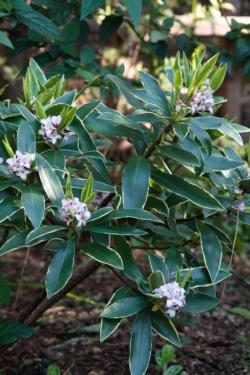 Daphnes emit a delightful fragrance in winter.
Daphnes emit a delightful fragrance in winter.Euphorbia (Euphorbia spp.) -- Not all euphorbias bloom in winter, but those that do provide an exotic touch to the winter landscape. There are more than 2,000 species of this deer-resistant plant. The most famous? The lovely poinsettia (Euphorbia pulcherrima), which is a festive indoor decoration but too frost tender for most outdoor applications.
Bleeding heart (Dicentra formosa) -- Here's a fragile-looking low bloomer that sprouts up in winter and early spring and then disappears for the rest of the year. It gets its name from its distinctive flowers. Bleeding hearts prefer a little shade.
Lenten rose (Helleborus spp.) -- The Lenten rose provides subtle yet stunning color and texture. There are numerous varieties, and there is likely to be a new hybrid in your nursery each winter. As an added bonus, the Lenten rose is deer resistant and has low water requirements.
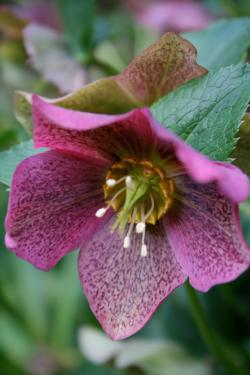 The Lenten rose comes in many colors.
The Lenten rose comes in many colors.Larger shrubs
Camellia (Camellia japonica) -- Despite the fact that camellias are extremely common, their beautiful rose-like flowers are always a pleasure to behold on a cold winter day. Camellias are related to rhododendrons and azaleas and thus prefer a little shade and acidic soil. Flower colors range from bright white to pink to deep red.
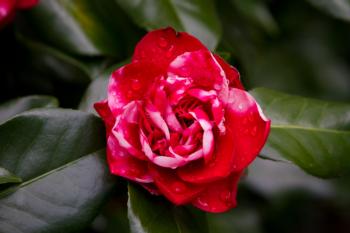 Camellias are a mainstay in the winter garden.
Camellias are a mainstay in the winter garden.Flowering quince (Chaenomeles spp.) -- If it's a six-foot punch of bright color you're after, look no further than this powerhouse. When the rest of the garden sleeps, the flowering quince shyly drops its leaves and then buds out with tremendous Asian-inspired flare. Often found in bright coral, red or white, flowering quince branches make striking indoor decorations.
Coast silktassel (Garrya elliptica) -- Here's one for gardeners who appreciate the texture and beauty of California native plants. As its name implies, the coast silktassel is draped in long, slim, rope-like tassels in winter. The rest of the year, this evergreen plant is a tumble of leathery dark green leaves that resemble coast live oak leaves.
Flowering currant (Ribes sanguineum) -- The flowering currant is a California native that turns heads. In late winter and early spring its long, drooping pink flowers are a beacon of color. Flowering currant attracts hummingbirds and is drought tolerant. It also offers gorgeous cut branches.
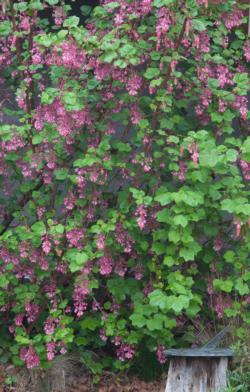 Flowering currant is a spectacular California native plant.
Flowering currant is a spectacular California native plant.Forsythia (Forsythia spp.) -- The neon yellow blooms of forsythia light up even the dreariest of winter days. This plant is frequently confused with one of our most invasive enemies, broom. Be sure the label says Forsythia.
Trees
Dogwood (Cornus spp.) -- There are many different types of dogwoods, and all of them are gorgeous late winter-early spring bloomers. Most are native to colder and wetter regions, which is a clue that these trees might need a little extra water and would appreciate some of Marin's cold pockets. Dogwoods also like a little afternoon shade.
Witch hazel (Hamamelis) -- These 12 to 15-foot trees are prized for their interesting yellow winter blooms as well as their bright fall foliage. Most witch hazels are fragrant and bloom over a long period. Like flowering currants and quince, the witch hazels provide stunning stems to include in winter bouquets.
Coral bark maple (Acer palmatum 'Sango Kaku') -- The young bark of this tree gleams bright red in winter. This is a good choice for Marin's coldest spots -- Marinwood, Novato and other frosty locations -- where the chilly weather helps redden the branches. Full disclosure: the reddest branches are those that are two years old or younger. As the tree ages the oldest branches turn a brownish green tinge.
VinesLilac vine (Hardenbergia spp.) -- The lilac vine is a common choice for covering chain link fences and other eyesores, with the bonus of spectacular purple color every winter. Its twining tendrils scramble quickly over anything in its way. Hardenbergia needs room to roam but does not demand much else. It requires little to no summer water but appreciates well-drained soil.
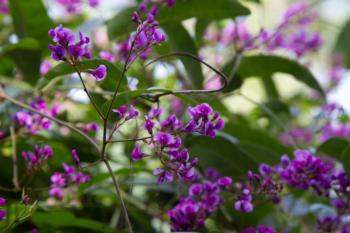 The lilac vine is a purple showstopper in winter.
The lilac vine is a purple showstopper in winter.Pink jasmine (Jasminum polyanthum) -- Pink jasmine oozes with fragrance most of the year and appreciates cool winter weather where it grows in every imaginable condition. Its blooms are white and the buds are burgundy to pink, giving the vine a multicolor look. This is one to keep an eye on: its speedy climbing tendrils will attach to anything, including house shingles and other shrubs.
Evergreen clematis (Clematis armandii) -- This evergreen climber may reach up to 30 feet, and its fragrant white flowers sweeten the air in late winter and early spring. It tolerates sun or part shade, although it likes shade on its roots. Like many climbers, the evergreen clematis must be kept in check and needs a strong support.
Succulents
Aloe ferox, Aloe arborensces, and Aloe ‘Johnson’s Hybrid’ are all winter bloomers. The beautiful coral aloe (Aloe striata) blooms at San Rafael’s Falkirk Cultural Center in late winter early spring. Drop by for a little winter inspiration.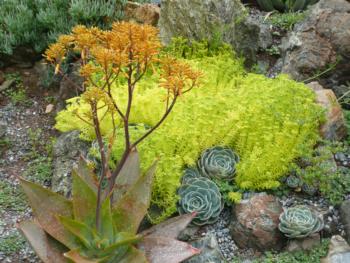 Succulents provide striking texture and color.
Succulents provide striking texture and color.Contributors: Faith Brown, Marie Narlock, Jessica Wasserman






